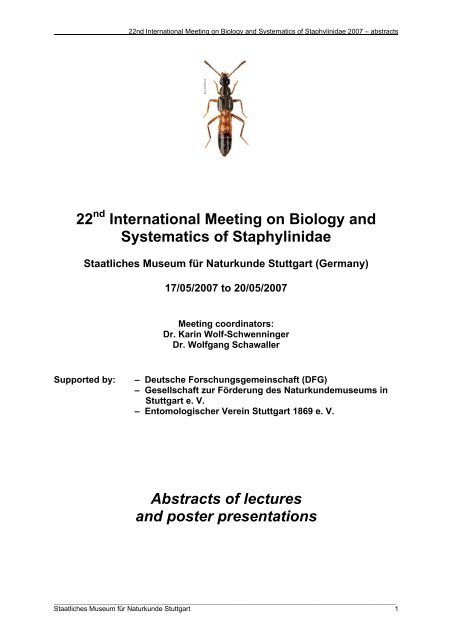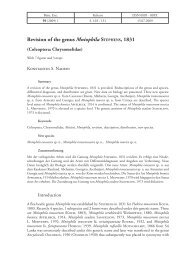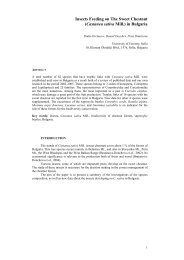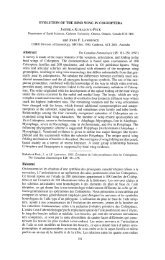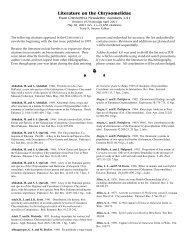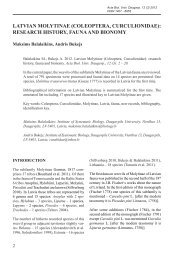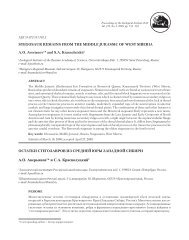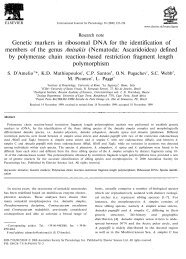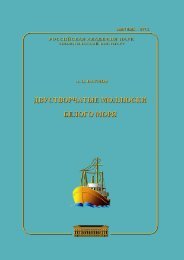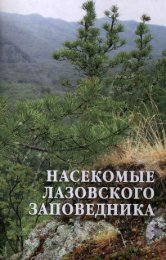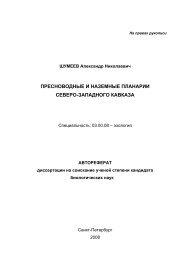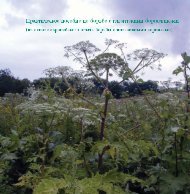International Meeting on Biology and Systematics of Staphylinidae
International Meeting on Biology and Systematics of Staphylinidae
International Meeting on Biology and Systematics of Staphylinidae
You also want an ePaper? Increase the reach of your titles
YUMPU automatically turns print PDFs into web optimized ePapers that Google loves.
22nd <str<strong>on</strong>g>Internati<strong>on</strong>al</str<strong>on</strong>g> <str<strong>on</strong>g>Meeting</str<strong>on</strong>g> <strong>on</strong> <strong>Biology</strong> <strong>and</strong> <strong>Systematics</strong> <strong>of</strong> <strong>Staphylinidae</strong> 2007 – abstracts<br />
22 nd <str<strong>on</strong>g>Internati<strong>on</strong>al</str<strong>on</strong>g> <str<strong>on</strong>g>Meeting</str<strong>on</strong>g> <strong>on</strong> <strong>Biology</strong> <strong>and</strong><br />
<strong>Systematics</strong> <strong>of</strong> <strong>Staphylinidae</strong><br />
Staatliches Museum für Naturkunde Stuttgart (Germany)<br />
17/05/2007 to 20/05/2007<br />
<str<strong>on</strong>g>Meeting</str<strong>on</strong>g> coordinators:<br />
Dr. Karin Wolf-Schwenninger<br />
Dr. Wolfgang Schawaller<br />
Supported by: – Deutsche Forschungsgemeinschaft (DFG)<br />
– Gesellschaft zur Förderung des Naturkundemuseums in<br />
Stuttgart e. V.<br />
– Entomologischer Verein Stuttgart 1869 e. V.<br />
Abstracts <strong>of</strong> lectures<br />
<strong>and</strong> poster presentati<strong>on</strong>s<br />
__________________________________________________________________________________________<br />
Staatliches Museum für Naturkunde Stuttgart 1
22nd <str<strong>on</strong>g>Internati<strong>on</strong>al</str<strong>on</strong>g> <str<strong>on</strong>g>Meeting</str<strong>on</strong>g> <strong>on</strong> <strong>Biology</strong> <strong>and</strong> <strong>Systematics</strong> <strong>of</strong> <strong>Staphylinidae</strong> 2007 – abstracts<br />
An evaluti<strong>on</strong> <strong>on</strong> Staphylinid beetles <strong>of</strong> Bozdağlar Mountain, Western Turkey,<br />
collected by different methods<br />
SINAN ANLAS<br />
Ege University, Science Faculty, Department <strong>of</strong> <strong>Biology</strong>, TR-35100 Bornova, Izmir, Turkey<br />
e-mail: anlasege@e-kolay.net<br />
In this study, communities <strong>of</strong> Staphylinid beetles were studied in Bozdaglar Mountain,<br />
Western Turkey, during the years 2001-2006 by using different methods: pitfall traps, hibernati<strong>on</strong><br />
traps <strong>and</strong> collecting by sifter from dung <strong>of</strong> cow.<br />
At the end <strong>of</strong> the study, a total <strong>of</strong> 70 species bel<strong>on</strong>ging to 34 genera in eight subfamilies<br />
have been recorded. The collecting methods have been compared <strong>and</strong> habitat density relati<strong>on</strong>s<br />
<strong>of</strong> <strong>Staphylinidae</strong> species have been evaluated.<br />
A revisi<strong>on</strong> <strong>of</strong> Micrillus Raffray<br />
VOLKER ASSING<br />
Gabelsbergerstr. 2, 30163 Hannover, Germany<br />
e-mail: vassing.hann@t-<strong>on</strong>line.de<br />
The main results <strong>of</strong> a recent revisi<strong>on</strong> <strong>of</strong> the paederine genus Micrillus Raffray are presented.<br />
Approximately 900 types <strong>and</strong> n<strong>on</strong>-type specimens were studied; various body parts <strong>of</strong><br />
almost 500 specimens were measured. Only 9 <strong>of</strong> the previously 25 valid species are c<strong>on</strong>firmed;<br />
as many as 17 new syn<strong>on</strong>ymies are proposed <strong>and</strong> <strong>on</strong>e name is resyn<strong>on</strong>ymised. Two new<br />
species are described <strong>and</strong> <strong>on</strong>e species is transferred from Scymbalium Erichs<strong>on</strong>, so that the<br />
genus now comprises a total <strong>of</strong> 12 species. These species are attributed to two species groups.<br />
In the Western Palaearctic regi<strong>on</strong> (including Middle Asia), the genus is represented by 10<br />
species, two <strong>of</strong> which are distributed in the border z<strong>on</strong>e between the southern West Palaearctic<br />
<strong>and</strong> the northern Afrotropical regi<strong>on</strong>; two species are recorded exclusively from the<br />
Afrotropical <strong>and</strong> the Oriental regi<strong>on</strong>s, respectively. The reas<strong>on</strong>s for the high degree <strong>of</strong> syn<strong>on</strong>ymy<br />
in the genus are illustrated. Based <strong>on</strong> several examples, especially the widespread M.<br />
testaceus (Erichs<strong>on</strong>), the - in some species enormous - extent <strong>of</strong> intraspecific variati<strong>on</strong> is analysed.<br />
At least three species are wing-dimorphic or -polymorphic. A pr<strong>on</strong>ounced dimorphism<br />
<strong>of</strong> eye size was found in two species. Data <strong>on</strong> the zoogeography <strong>and</strong> ecology <strong>of</strong> the species<br />
are compiled <strong>and</strong> illustrated.<br />
Life History <strong>and</strong> Habits <strong>of</strong> Rove Beetles (Coleoptera, <strong>Staphylinidae</strong>): Laboratory<br />
study<br />
ANDREY BABENKO<br />
Tomsk State University, Tomsk 634050, Russia<br />
e-mail: dzedzin17@hotmail.com<br />
Life history <strong>of</strong> most <strong>Staphylinidae</strong> is studied insufficiently. Only 5% <strong>of</strong> publicati<strong>on</strong>s <strong>on</strong><br />
systematics <strong>of</strong> <strong>Staphylinidae</strong> are devoted to studying preadult stages <strong>of</strong> beetles. Even in Central<br />
Europe preadult stages, development cycles, peculiarities <strong>of</strong> behavior <strong>and</strong> other features <strong>of</strong><br />
life history <strong>of</strong> a lot <strong>of</strong> species are still unknown. Until now <strong>on</strong>ly larvae <strong>of</strong> approximately 300<br />
__________________________________________________________________________________________<br />
Staatliches Museum für Naturkunde Stuttgart 2
22nd <str<strong>on</strong>g>Internati<strong>on</strong>al</str<strong>on</strong>g> <str<strong>on</strong>g>Meeting</str<strong>on</strong>g> <strong>on</strong> <strong>Biology</strong> <strong>and</strong> <strong>Systematics</strong> <strong>of</strong> <strong>Staphylinidae</strong> 2007 – abstracts<br />
<strong>Staphylinidae</strong> species have been described, which is 1% <strong>of</strong> the whole number <strong>of</strong> known imagines.<br />
Only the biology <strong>of</strong> Aleochara, being used in a number <strong>of</strong> countries as agents <strong>of</strong> bioc<strong>on</strong>trol,<br />
has been studied in detail. For example, life history <strong>of</strong> Aleochara bilineata Gyll. has<br />
been studied in detail, <strong>and</strong> methods <strong>of</strong> rearing this species have been developed (Read, 1962;<br />
Whistlecraft et al.,1985).<br />
We studied the biology <strong>of</strong> <strong>Staphylinidae</strong> under laboratory c<strong>on</strong>diti<strong>on</strong>s in 1982-2005. Life<br />
history <strong>of</strong> 39 staphylinid species from 6 subfamilies has been studied. Methods <strong>of</strong> laboratory<br />
cultivati<strong>on</strong> <strong>on</strong> natural media have been used (Tikhomirova <strong>and</strong> Melnikov, 1975; Babenko,<br />
1991).<br />
Each species <strong>of</strong> <strong>Staphylinidae</strong> has its own temperature limits <strong>of</strong> locomoti<strong>on</strong> <strong>and</strong> feeding<br />
activity. Copulati<strong>on</strong> <strong>of</strong> Omaliinae is observed at 10ºС, but for Xantholininae at 16ºС <strong>on</strong>ly.<br />
Most representatives <strong>of</strong> Xantholininae <strong>and</strong> Staphylininae subfamilies have high activity <strong>of</strong><br />
males in the period <strong>of</strong> copulati<strong>on</strong> <strong>and</strong> impulsive, with periods <strong>of</strong> depressi<strong>on</strong>, activity <strong>of</strong> females.<br />
Observing large representatives <strong>of</strong> Staphylininae (Staphylinus fulvipes Scop., Creophilus<br />
maxillosus L., Phil<strong>on</strong>thus politus L., Phil<strong>on</strong>thus decorus Grav., Ontholestes tesselatus Four.)<br />
has shown that c<strong>on</strong>tacts <strong>of</strong> specimens <strong>of</strong> the same sex reveal mutual aggressi<strong>on</strong> <strong>and</strong> beetles<br />
run away after a short fighting. The durati<strong>on</strong> <strong>of</strong> copulati<strong>on</strong> changes from 20 sec (Trogophloeus<br />
bilineatus Gyll.) up to 5 minutes (Eusphalerum minutum F.). Phil<strong>on</strong>thus dimidiatus<br />
Sahlberg has the l<strong>on</strong>gest period <strong>of</strong> ovipositi<strong>on</strong> – more than four m<strong>on</strong>ths. It has been observed<br />
that 5 females laid 496 eggs.<br />
Large predators lay less eggs (Staphylinus fulvipes Scop. 15 to 24 eggs, Phil<strong>on</strong>thus<br />
decorus Grav. <strong>and</strong> Phil<strong>on</strong>thus ebeninus Grav. up to 65 eggs). Small rove beetles are characterized<br />
by higher fertility: Oxytelus rugosus F. <strong>and</strong> some Megarthrus spp. up to 80-100 eggs,<br />
<strong>and</strong> for Aleochara bilineata Gyll. a high producti<strong>on</strong> <strong>of</strong> eggs is observed: up to 1000 eggs (Adashkevich,<br />
1972).<br />
The places <strong>of</strong> oviopositi<strong>on</strong> depend <strong>on</strong> rove beetles niche. Some species lay eggs open <strong>on</strong><br />
the surface <strong>of</strong> soil <strong>and</strong> forest litter (Drusilla canaliculata F., some species <strong>of</strong> Tachinus,<br />
Quedius, Phil<strong>on</strong>thus). Some beetles hide eggs as deep as 1,5 сm (the majority <strong>of</strong> Staphylinus<br />
<strong>and</strong> Ocypus) Representatives <strong>of</strong> Oxyporus, Gyrophaena, Megarthrus lay eggs inside mushrooms.<br />
Small beetles living under bark (Nudobius lentus Grav. <strong>and</strong> Placusa) lay eggs just in<br />
this place. Representatives <strong>of</strong> Oxytelus build cells in s<strong>of</strong>t media. Some <strong>Staphylinidae</strong> are characterized<br />
by taking care for their <strong>of</strong>fspring: e. g. the female <strong>of</strong> Platystethus arenarius Four.<br />
protects its eggs in special cells against predators trying to penetrate into the cell. It strikes<br />
them using m<strong>and</strong>ibula <strong>and</strong> the top <strong>of</strong> the abdomen.<br />
The development period <strong>of</strong> larvae <strong>and</strong> pupae depends <strong>on</strong> temperature <strong>and</strong> place <strong>of</strong> living.<br />
Most part <strong>of</strong> dung-living <strong>and</strong> mushroom-living <strong>Staphylinidae</strong> have the shortest period <strong>of</strong> larval<br />
<strong>and</strong> pupal development. Survival <strong>of</strong> larvae depends <strong>on</strong> what they eat during the first hours<br />
after their escape from eggs. Big representatives <strong>of</strong> Phil<strong>on</strong>thus live without food up to 2 days,<br />
<strong>and</strong> larvae <strong>of</strong> older ages up to 7 days. When temperature decreases the period <strong>of</strong> development<br />
becomes l<strong>on</strong>ger in Staphylininae <strong>and</strong> Paederinae (2-3 times) <strong>and</strong> in Omaliinae <strong>and</strong> Oxytelinae<br />
(1,5 times).<br />
The process <strong>of</strong> pupa c<strong>on</strong>structi<strong>on</strong> takes place, as a rule, in the different shelters. For example,<br />
larvae <strong>of</strong> some Aleocharinae produce the pupa in a special silk coco<strong>on</strong>, using small<br />
particles <strong>of</strong> s<strong>and</strong> <strong>and</strong> mushrooms. We studied the making <strong>of</strong> silk coco<strong>on</strong>s by larvae <strong>of</strong> Oxytelinae,<br />
Aleocharinae <strong>and</strong> Staphylininae. Larvae <strong>of</strong> Atheta sp., living in sulfur shelf mushroom,<br />
make coco<strong>on</strong>s in the lower part <strong>of</strong> the mushroom or, under laboratory c<strong>on</strong>diti<strong>on</strong>s, in s<strong>and</strong>.<br />
First <strong>of</strong> all, a larva glues small parts <strong>of</strong> substrate making a circle-like wall, the diameter <strong>of</strong><br />
which is approximately the same as the length <strong>of</strong> a larva’s body. Then it makes a kind <strong>of</strong> net<br />
over the wall. The process <strong>of</strong> making coco<strong>on</strong> by larvae <strong>of</strong> Oxytelus sculpturatus Grav. is<br />
__________________________________________________________________________________________<br />
Staatliches Museum für Naturkunde Stuttgart 3
22nd <str<strong>on</strong>g>Internati<strong>on</strong>al</str<strong>on</strong>g> <str<strong>on</strong>g>Meeting</str<strong>on</strong>g> <strong>on</strong> <strong>Biology</strong> <strong>and</strong> <strong>Systematics</strong> <strong>of</strong> <strong>Staphylinidae</strong> 2007 – abstracts<br />
simpler. They drill into the substrate <strong>and</strong> make a thin transparent coco<strong>on</strong> around their bodies.<br />
Larvae <strong>of</strong> Drusilla canaliculata F. make coco<strong>on</strong>s like a net with big cells. This process takes<br />
place in cells in damp substrate. Big predators – Ontholestes tesselatus Four. <strong>and</strong> O. murinus<br />
L. – make coco<strong>on</strong>s with the shape <strong>of</strong> a cylinder. They were placed in small holes within the<br />
substrate which the larvae have made before.<br />
Staphylinid beetle communities (Coleoptera, <strong>Staphylinidae</strong>) <strong>of</strong> virginal forests<br />
in the central Europe – endangered species <strong>and</strong> c<strong>on</strong>servati<strong>on</strong> measures<br />
JAROSLAV BOHÁČ<br />
Faculty <strong>of</strong> Agriculture, University <strong>of</strong> South Bohemia,<br />
Studentská 13, 370 05 České Budějovice, Czech Republic<br />
e-mail: jardaboh@seznam.cz<br />
Staphylinid beetle communities were studied in virginal forests <strong>on</strong> 3 localities: Nati<strong>on</strong>al<br />
Nature Reserves (NNR) in the Boubín massive in Šumava Mts. (NNR Čertova stěna – forest<br />
<strong>and</strong> stream, NNR Zátoňská hora – forest, NNR Milešický prales – forest, NNR Jilmová skála<br />
– forest, NNR Ž<strong>of</strong>ínský prales <strong>and</strong> NNR Hojná voda in Novohradské hory Mts. (forest, shore<br />
<strong>of</strong> a stream) <strong>and</strong> NNR Mi<strong>on</strong>ší in Beskydy Mts. (forest, artificial meadow).<br />
Aim <strong>of</strong> the study was:<br />
– to describe the community structure <strong>of</strong> staphylinids in virginal forest situated in Šumava<br />
Mts., Novohradské hory Mts. <strong>and</strong> Beskydy Mts.,<br />
– to prepare a base for the next m<strong>on</strong>itoring <strong>of</strong> staphylinids communities, to compare results<br />
with similar studies in Bavaria <strong>and</strong> Romania.Pitfall trapping <strong>and</strong> soil sampling<br />
with the sifter, individual collecti<strong>on</strong> (fungi, dead wood, etc.), shaking <strong>and</strong> slipping, collecting<br />
under the bark were used for beetles studying. The efficiency <strong>of</strong> used methods for the occuring<br />
<strong>of</strong> species in virginal forest (in %) was different <strong>and</strong> the combinati<strong>on</strong> <strong>of</strong> methods is needed<br />
for studies <strong>of</strong> biodiversity in virginal forest due to the numerous ecological strata (see<br />
following table).<br />
Efficiency <strong>of</strong> used methods for the occuring <strong>of</strong> staphylinid species in virginal forest:<br />
Shaking Slipping Pitfall trapping Sifting Collecting under bark Other methods<br />
19,27 % 21,69 % 6,02 % 32,63 % 15,66 % 4,42 %<br />
The highest number <strong>of</strong> staphylinid species <strong>and</strong> species <strong>of</strong> the Red Book <strong>and</strong> Urwald indicator<br />
species (Müller et al., 2005) occurs in the Mi<strong>on</strong>ší NNR in Beskydy Mts.(110 species).<br />
This locality reaches by its biodiversity to the highest biodiversity <strong>of</strong> Urwald species known<br />
from the Rumanian virginal forests (see Müller et al., 2005). The number <strong>of</strong> species <strong>and</strong> rare<br />
<strong>and</strong> Urwald species known from the Šumava <strong>and</strong> Novohradské hory Mts. is similar with the<br />
natural forests in Nati<strong>on</strong>al Park Bavarian Forest (Germany) (50-70 species). The next rare <strong>and</strong><br />
endangered staphylinids occur in studied localities: Atrecus l<strong>on</strong>giceps (Fauvel, 1873), Gabrius<br />
bescidicus (Smetana, 1952), Gyrophaena rousi (Dvořák, 1966), Lordith<strong>on</strong> speciosus (Erichs<strong>on</strong>,<br />
1839) <strong>and</strong> Olisthaerus substriatus (Paykull, 1790). The last species is known from the<br />
Boubín massive in Šumava Mts. as the <strong>on</strong>ly <strong>on</strong>e locality in the Czechia. The climatic change<br />
are the possible most dangerous cause for Urwald staphylinid species generally (shift <strong>of</strong> vegetati<strong>on</strong>al<br />
z<strong>on</strong>es). The comm<strong>on</strong> studies are needed with Bavarian, Polish <strong>and</strong> Slovakian colleagues<br />
dealing with staphylinids as indicators <strong>of</strong> forest naturalness <strong>and</strong> human effect in the<br />
central Europe.<br />
__________________________________________________________________________________________<br />
Staatliches Museum für Naturkunde Stuttgart 4
22nd <str<strong>on</strong>g>Internati<strong>on</strong>al</str<strong>on</strong>g> <str<strong>on</strong>g>Meeting</str<strong>on</strong>g> <strong>on</strong> <strong>Biology</strong> <strong>and</strong> <strong>Systematics</strong> <strong>of</strong> <strong>Staphylinidae</strong> 2007 – abstracts<br />
On the systematic positi<strong>on</strong> <strong>of</strong> Endeius Coiffait <strong>and</strong> Sáiz (<strong>Staphylinidae</strong>,<br />
Staphylininae)<br />
MARIANA R. CHANI-POSSE<br />
Laboratorio de Entomología, Instituto Argentino de Investigaci<strong>on</strong>es de las Z<strong>on</strong>as Aridas<br />
(IADIZA, CRICYT), Casilla de Correo 507, 5500 Mendoza, Argentina.<br />
e-mail: mchani@lab.cricyt.edu.ar<br />
The Austral South American genus Endeius Coiffait <strong>and</strong> Sáiz bel<strong>on</strong>gs to the Phil<strong>on</strong>thina,<br />
a very speciose subtribe <strong>of</strong> <strong>Staphylinidae</strong>, particularly in the tropics where many genera have<br />
not been revised since their original descripti<strong>on</strong>. Endeius, as it is currently known, comprises<br />
eight valid species distributed from Chile <strong>and</strong> Argentina through Juan Fernández Is. <strong>and</strong> Galapagos<br />
Is.: E. nitidipennis (Solier), E. punctipennis (Solier), E. loensis Coiffait & Sáiz, E.<br />
subpunctipennis Coiffait & Sáiz, E. franzi Sáiz, E. lugubris Sáiz, E. multipunctatus Coiffait<br />
<strong>and</strong> E. ovaliceps Coiffait.<br />
Coiffait´s treatment <strong>of</strong> the Staphylininae relied heavily <strong>on</strong> the structures <strong>of</strong> male genitalia,<br />
<strong>and</strong> affected the natural classificati<strong>on</strong> both at the generic <strong>and</strong> species level within the subfamily.<br />
The systematic positi<strong>on</strong> <strong>of</strong> Endeius was estimated by a cladistic analysis <strong>and</strong> its phylogenetic<br />
relati<strong>on</strong>ships with other representatives within Phil<strong>on</strong>thina were evaluated. Twenty<br />
terminal units were included in the cladistic analysis, the eight species <strong>of</strong> Endeius, <strong>and</strong> twelve<br />
outgroup taxa. Chosen outgroups to root the tree were <strong>on</strong>e representative within Xanthopygina,<br />
<strong>on</strong>e within Quediina <strong>and</strong> ten representatives within Phil<strong>on</strong>thina: <strong>on</strong>e in the genus Chroaptomus<br />
Sharp, two in Gabrius Stephens, two in Bisnius Stephens, two in Bel<strong>on</strong>uchus Nordmann<br />
<strong>and</strong> three in Phil<strong>on</strong>thus Stephens. Fifty-six characters were used, from which 35 were<br />
derived from the external morphology, 19 from male genitalia <strong>and</strong> two from female genitalia.<br />
Twenty-<strong>on</strong>e multistate characters were treated as unordered (n<strong>on</strong>-additive). Two search criteria<br />
were used: a) equally weighted analysis (EW), <strong>and</strong> b) implied weighting method (IW, Golob<strong>of</strong>f<br />
1993). Data matrix was analyzed with TNT (Golob<strong>of</strong>f 1999). The EW analysis <strong>of</strong> the<br />
data matrix produced <strong>on</strong>e cladogram with 178 steps. Results from the IW analysis were<br />
c<strong>on</strong>gruent with those from the EW criteria.<br />
The cladogram shows the eight Endeius species as a n<strong>on</strong>-m<strong>on</strong>ophyletic group. Its comparis<strong>on</strong><br />
with a re-rooted tree supports this hypothesis. Endeius can be c<strong>on</strong>sidered as a “natural<br />
group” <strong>on</strong>ly for four <strong>of</strong> its species including the type species, E. loensis. The group is defined<br />
by: sec<strong>on</strong>d segment <strong>of</strong> maxillary palpus moderately to distinctly swollen, <strong>and</strong> more than five<br />
punctures at dorsal rows <strong>of</strong> pr<strong>on</strong>otum.<br />
Systematic Problems in the Euaesthetinae (Coleoptera: <strong>Staphylinidae</strong>)<br />
DAVE J. CLARKE<br />
Divisi<strong>on</strong> <strong>of</strong> Insects, The Field Museum <strong>of</strong> Natural History,<br />
1400 S Lake Shore Drive, Chicago, IL 60605.<br />
University <strong>of</strong> Illinois, at Chicago<br />
email: dclarke@fmnh.org.<br />
The subfamily Euaesthetinae c<strong>on</strong>tains approximately 800 described species in 27 genera<br />
(1 fossil, 2 undescribed), which are currently placed into 6 tribes: Austroesthetini (5), Alzadaesthetini<br />
(1), Euaesthetini (12), Fenderiini (2), Nordenskioldiini (3) <strong>and</strong> Stenaesthetini<br />
(4). This tribal classificati<strong>on</strong> was based <strong>on</strong> tarsal formula <strong>and</strong> the presence or absence <strong>of</strong> a<br />
margined abdomen <strong>and</strong> wings, <strong>and</strong> has been questi<strong>on</strong>ed by many authors. The m<strong>on</strong>ophyly <strong>of</strong><br />
__________________________________________________________________________________________<br />
Staatliches Museum für Naturkunde Stuttgart 5
22nd <str<strong>on</strong>g>Internati<strong>on</strong>al</str<strong>on</strong>g> <str<strong>on</strong>g>Meeting</str<strong>on</strong>g> <strong>on</strong> <strong>Biology</strong> <strong>and</strong> <strong>Systematics</strong> <strong>of</strong> <strong>Staphylinidae</strong> 2007 – abstracts<br />
the clade Euaesthetinae + Steninae is well established, but recent published studies have suggested<br />
that Euaesthetinae is paraphyletic with respect to Steninae, as there are no known autapomorphies<br />
for Euaesthetinae. This talk reviews some major systematic problems within the<br />
clade Euaesthetinae + Steninae, pitches these problems within a phylogenetic c<strong>on</strong>text, <strong>and</strong><br />
focuses <strong>on</strong> the south temperate endemic genera.<br />
Almost half <strong>of</strong> the known euaesthetine genera <strong>and</strong> two <strong>of</strong> the tribes (Austroesthetini, Alzadaesthetini)<br />
are endemic to the south temperate regi<strong>on</strong> <strong>and</strong> the relati<strong>on</strong>ships <strong>of</strong> these genera<br />
to each other <strong>and</strong> to other genera are unknown. Some major morphological characters are reviewed,<br />
including potential autapomorphies for Euaesthetinae, <strong>and</strong> using recent adult morphological<br />
data some new hypotheses for generic relati<strong>on</strong>ships are explored. It is suggested that<br />
Alzadaesthetini, most <strong>of</strong> the genera <strong>of</strong> Austroesthetini, <strong>and</strong> Stenaesthetini may be more<br />
closely related to each other than to members <strong>of</strong> any other tribes. Two new undescribed genera<br />
<strong>and</strong> their systematic placement are briefly discussed in light <strong>of</strong> these other hypotheses. It<br />
is c<strong>on</strong>cluded that phylogenetic studies <strong>of</strong> the Euaesthetinae will be significantly hampered by<br />
the dominance <strong>of</strong> homoplastic characters, reducti<strong>on</strong>s, <strong>and</strong> parallel changes related to the specialized<br />
habitats <strong>of</strong> these beetles. A phylogenetic reclassificati<strong>on</strong> <strong>of</strong> the subfamily will likely<br />
require the input <strong>of</strong> molecular data <strong>and</strong> high-density tax<strong>on</strong> sampling across all genera to reach<br />
stability, <strong>and</strong> still seems to be a distant reality.<br />
About Stenus aggregates <strong>on</strong> top <strong>of</strong> Mt Borail (Assam, India)<br />
GIULIO CUCCODORO<br />
Muséum d’histoire naturelle, Genève, Switzerl<strong>and</strong><br />
e-mail: Giulio.Cuccodoro@ville-ge.ch<br />
The Mt Borail is located in North East India in the South <strong>of</strong> the State <strong>of</strong> Assam (Axom).<br />
This about 1800 m high mountain is still densely covered with lush forests. On the 17th <strong>of</strong><br />
October 2005, I climbed it together with Aless<strong>and</strong>ro Marletta (Catania, Italy) <strong>and</strong> my Hado<br />
Kookie friend Chungkholien Lhouvum (Notun Leikul, Assam). We reached the summital<br />
clearing at 2.30 PM. It was cloudy with almost no wind. There, our attenti<strong>on</strong> was casually<br />
drawn <strong>on</strong>to the base <strong>of</strong> a nearby tree at the forest edge by dozens <strong>of</strong> tiny dark mobile spots<br />
c<strong>on</strong>trasting with its pale bark. Giving the tree a closer look, I so<strong>on</strong> realised that the dark spots<br />
were adults Stenus Latreille (Coleoptera <strong>Staphylinidae</strong> Steninae). They were present in such a<br />
number that they could be found almost everywhere <strong>on</strong> the trunk up to 1.5 m high, as well as<br />
<strong>on</strong> the surrounding couple <strong>of</strong> square meters <strong>of</strong> vegetati<strong>on</strong>. They were all together well above<br />
5'000 specimens as if uniformly scattered at a 3-5 cm distance from each other <strong>on</strong> the bark<br />
<strong>and</strong> leaves <strong>of</strong> the tree, as well as <strong>on</strong> neighbouring mosses, ferns, grasses, branches <strong>and</strong> other<br />
vegetati<strong>on</strong>al debris <strong>on</strong> the ground. Density <strong>of</strong> individuals was particularly high underneath<br />
some recurved dead broadleaves <strong>and</strong> in shallow cavities <strong>of</strong> the trunk, where they could form a<br />
nearly compact layer exceeding 5 individuals / cm<br />
__________________________________________________________________________________________<br />
2 . Most individuals appeared moderately<br />
active, <strong>and</strong> they were many couples in copula. I sampled several hundreds <strong>of</strong> specimens <strong>of</strong><br />
various sizes, all <strong>of</strong> which proved later to bel<strong>on</strong>g to an undescribed species <strong>of</strong> Stenus resembling<br />
S. stigmaticus Fauvel (V. Puthz pers. com.). The aggregate was still going <strong>on</strong> when we<br />
left the place at 3.30 PM. The next morning we returned to the summital clearing <strong>and</strong> decided<br />
to stay there for a couple <strong>of</strong> nights. The top <strong>of</strong> Mt Borail was in the clouds at our late morning<br />
arrival <strong>and</strong> by no<strong>on</strong> a gentle drizzle started moisturing the place. We couldn’t find even a single<br />
Stenus <strong>on</strong> or near ‘the’ trunk before rain poored <strong>on</strong> us from 3 PM until late at night. The<br />
19th <strong>of</strong> October was sunny until the late morning formati<strong>on</strong> <strong>of</strong> a thick layer <strong>of</strong> altostratus,<br />
which obscured the sun throughout the afterno<strong>on</strong>. It was about 1 PM when we first noticed<br />
Staatliches Museum für Naturkunde Stuttgart 6
22nd <str<strong>on</strong>g>Internati<strong>on</strong>al</str<strong>on</strong>g> <str<strong>on</strong>g>Meeting</str<strong>on</strong>g> <strong>on</strong> <strong>Biology</strong> <strong>and</strong> <strong>Systematics</strong> <strong>of</strong> <strong>Staphylinidae</strong> 2007 – abstracts<br />
adults Stenus gradually turning up again near the same particular tree, as if they were materialising<br />
from nowhere. In the matter <strong>of</strong> half an hour the aggregate resumed exactly at the same<br />
place as two days before <strong>and</strong> with a similar intensity. At around 4 PM, the attendants at the<br />
aggregate appeared to have significantly decreased in number, <strong>and</strong> they were all g<strong>on</strong>e before<br />
sunset a 4h30 PM. I returned to Mt Borail in 2006 <strong>and</strong> camped <strong>on</strong> its summital clearing from<br />
November 15 to 29. Moderate drought c<strong>on</strong>diti<strong>on</strong>s due to a deficient m<strong>on</strong>so<strong>on</strong> allowed me to<br />
experience mostly sustained winds without altostratus cover, <strong>and</strong> <strong>on</strong>ly two night showers.<br />
This abnormal climate for the seas<strong>on</strong> might eventually explain why I hadn’t the chance to<br />
observe an other Stenus aggregate throughout this sec<strong>on</strong>d <strong>and</strong> much l<strong>on</strong>ger stay <strong>on</strong> top <strong>of</strong> Mt<br />
Borail.<br />
This is <strong>on</strong>ly the eighth aggregate <strong>of</strong> <strong>Staphylinidae</strong> reported since Lé<strong>on</strong> Fairmaire first<br />
menti<strong>on</strong>ed the phenomenom in 1856. Six <strong>of</strong> them c<strong>on</strong>sisted in Stenus <strong>and</strong> <strong>on</strong>e c<strong>on</strong>sisted in<br />
Dianous Leach, with figures ranging from several hundreds to more than 30'000 individuals.<br />
So far the <strong>on</strong>ly aggregate <strong>of</strong> <strong>Staphylinidae</strong> reported out <strong>of</strong> Steninae c<strong>on</strong>sisted in several hundreds<br />
<strong>of</strong> Ilyusa fugax Erichs<strong>on</strong> (Aleocharinae) observed in 1955 by Henri Coiffait near the<br />
entrance <strong>of</strong> a cave in Leban<strong>on</strong>.<br />
This phenomenom, which seems quite rare <strong>and</strong> unpredictible, is apparently associated<br />
with reproducti<strong>on</strong>, but the precise factors (seas<strong>on</strong>al, weather c<strong>on</strong>diti<strong>on</strong>s, topography, etc.)<br />
leading occasi<strong>on</strong>ally so many individuals <strong>of</strong> a single species <strong>of</strong> <strong>Staphylinidae</strong> to gather together<br />
in such a way remain unclear.<br />
Species diversity <strong>of</strong> <strong>Staphylinidae</strong> in the Neman river basin in Belarus<br />
ALEXANDER DERUNKOV<br />
Institute <strong>of</strong> Zoology, Nati<strong>on</strong>al Acad. <strong>of</strong> Sci. <strong>of</strong> Belarus, Minsk, Belarus<br />
e-mail: alex_derunkov@tut.by<br />
Natural features <strong>of</strong> European floodplains are the result <strong>of</strong> dynamic geomorphological<br />
processes that lead to a high habitat diversity <strong>of</strong> these ecosystems. Floodplain management<br />
<strong>and</strong> c<strong>on</strong>servati<strong>on</strong> requires a sound underst<strong>and</strong>ing both <strong>of</strong> species-envir<strong>on</strong>ment <strong>and</strong> speciesspecies<br />
relati<strong>on</strong>ships in the communities, guilds etc. So, there is a need to collect so much as<br />
possible quantitative rather than qualitative data, first <strong>of</strong> all <strong>on</strong> the populati<strong>on</strong> dynamics <strong>and</strong><br />
energy flow. It is important to clear up the role <strong>of</strong> physical <strong>and</strong> biotic factors, <strong>and</strong> how these<br />
interact am<strong>on</strong>g the different levels <strong>of</strong> riverine study (from <strong>on</strong>e well-defined habitat to river<br />
basin).<br />
Presented data were collected in course <strong>of</strong> the study <strong>of</strong> staphylinid assemblages in the<br />
floodplains in Belarus. Material was collected during 2005 – 2006 in the floodplains <strong>of</strong> Neman<br />
river <strong>and</strong> its right tributary – Shchara river. The Neman river flows in the north-western<br />
part <strong>of</strong> Belarus in general East to West directi<strong>on</strong>.<br />
The main objectives <strong>of</strong> this study were to find out changes in the staphylinid assemblages<br />
structure in the spatial gradient from river source to middle river course <strong>and</strong> to define<br />
the structure <strong>of</strong> staphylinid assemblages in the open versus forested habitats in floodplains <strong>of</strong><br />
the studied rivers. To solve this problem, material was collected in 9 study sites al<strong>on</strong>g the entire<br />
courses <strong>of</strong> Shchara <strong>and</strong> Neman rivers. The study was carried out in the c<strong>on</strong>text taking into<br />
account the structure <strong>of</strong> vertebrate predator (amphibian) assemblages. Therefore, habitats with<br />
c<strong>on</strong>centrati<strong>on</strong>s <strong>of</strong> feeding amphibians were selected. Forested habitats sampled were mostly<br />
__________________________________________________________________________________________<br />
Staatliches Museum für Naturkunde Stuttgart 7
22nd <str<strong>on</strong>g>Internati<strong>on</strong>al</str<strong>on</strong>g> <str<strong>on</strong>g>Meeting</str<strong>on</strong>g> <strong>on</strong> <strong>Biology</strong> <strong>and</strong> <strong>Systematics</strong> <strong>of</strong> <strong>Staphylinidae</strong> 2007 – abstracts<br />
black alder forests <strong>and</strong> floodplain oak forest patches. Floodplain meadows were selected as<br />
open habitats.<br />
Beetles were collected by pitfall trapping <strong>and</strong> soil sampling. Plastic cups with an opening<br />
diameter <strong>of</strong> 75 mm <strong>and</strong> a volume <strong>of</strong> 250 ml were used as pitfall traps. A formalin mixture<br />
(4 %) was used as a fixing agent. Fifteen traps were located in every site in the open <strong>and</strong> in<br />
the forested habitat. The traps were serviced <strong>on</strong>ce in 3 weeks during the period from May to<br />
October each year. Soil samples were collected <strong>on</strong>ly in the forested habitats <strong>and</strong> sampling was<br />
d<strong>on</strong>e <strong>on</strong>ly at a depth <strong>of</strong> forest litter. Samples at eight 25х25 cm plots were collected at every<br />
site. Substantial amount <strong>of</strong> specimens was collected, <strong>and</strong> this material was identified <strong>and</strong> analyzed<br />
<strong>on</strong>ly partially as <strong>of</strong> today. In the presentati<strong>on</strong>, we used the soil sample data from 2 sites<br />
in the Shchara river floodplain <strong>and</strong> from 3 sites in the Neman river floodplain. The Neman<br />
data used are from the upper <strong>and</strong> middle river courses collected in spring (May – early June).<br />
The Upper Neman river floodplain was c<strong>on</strong>siderably affected by drainage meliorati<strong>on</strong>,<br />
therefore floodplain meadows are substantially anthropogenically transformed. Nevertheless,<br />
they are under an impact <strong>of</strong> seas<strong>on</strong>al flooding that influences the Staphylinid species compositi<strong>on</strong>.<br />
The forested habitats there primarily represented by black alder forests. The upl<strong>and</strong> dry<br />
pine forests <strong>and</strong> mixed forests including pine, spruce, birch, aspen <strong>and</strong> other deciduous trees<br />
grow <strong>on</strong> the upper layers <strong>of</strong> river terraces.<br />
Open habitats in the Middle Neman (the sec<strong>on</strong>d study site) <strong>and</strong> in the Shchara river<br />
mouth were represent by typical floodplain meadows. Plots <strong>on</strong> the elevated parts <strong>of</strong> floodplain<br />
meadows are not subjected to flooding. The species compositi<strong>on</strong> at those sites includes xerophilous<br />
<strong>and</strong> even steppe elements. The forested patches in the floodplain were represented by<br />
old growth oak or black alder forests. These forests are affected by seas<strong>on</strong>al flooding during<br />
most <strong>of</strong> the years. There are numerous temporary pools in the floodplain, many <strong>of</strong> which may<br />
persist till the middle or even the end <strong>of</strong> summer. The mature oak forests in the Middle Neman<br />
regi<strong>on</strong> are under legal protecti<strong>on</strong> by the state.<br />
According to the soil sample data, the most comm<strong>on</strong> species in the forest litter are Geostiba<br />
circellaris <strong>and</strong> Atheta fungi. They were found in all studied sites <strong>and</strong> their densities were<br />
from 2 to 58 specimens/square meter. The most diverse species compositi<strong>on</strong> <strong>of</strong> staphylinids<br />
was found out in the black alder forest in the Upper Neman. The hygrophilous species from<br />
the genera Gabrius, Phil<strong>on</strong>thus, Stenus, Carpelimus, Dochm<strong>on</strong>ota clancula were diverse in<br />
the alder forest. Mesophilous forest species Xantholinus linearis, Othius myrmecophilus,<br />
Othius punctulatus, Anthobium atrocephalum <strong>and</strong> Cypha l<strong>on</strong>gicornis were more comm<strong>on</strong> in<br />
the floodplain oak forests.<br />
Similarity analysis <strong>of</strong> staphylinid assemblages in the floodplain forests has revealed that<br />
staphylinid assemblages from the same forest types are more similar. No any other pattern<br />
was found out in the similarity <strong>of</strong> staphylinid assemblages according to the quantitative data.<br />
Staphylinid species compositi<strong>on</strong> as identified by pitfall trapping was much more diverse<br />
in comparis<strong>on</strong> with the soil samples data. 83 species were identified. One <strong>of</strong> the most interesting<br />
faunistic discoveries was Xantholinus dvoraki recorded for the first time <strong>on</strong> the Belarusian<br />
territory. This species is regarded as stenotopic inhabitant <strong>of</strong> floodplain meadows, but I didn’t<br />
collect this species during my previous 8-year-l<strong>on</strong>g studies in the riverine habitats in Belarus.<br />
10 specimens <strong>of</strong> this species were collected in 2006 <strong>on</strong> a floodplain meadow in the Middle<br />
Neman. Ischnosoma l<strong>on</strong>gicorne was collected there too. This hygrophilous eurytopic species,<br />
inhabiting swampy forests <strong>and</strong> wetl<strong>and</strong>s in floodplains is found much rarer than Ischnosoma<br />
splendidum, which is comm<strong>on</strong> in different forested <strong>and</strong> open habitats. Two species rare in<br />
Belarus were found in the Upper Neman study sites. Carpelimus el<strong>on</strong>gatulus, a species <strong>of</strong><br />
swampy meadows <strong>and</strong> banks <strong>of</strong> p<strong>on</strong>ds, rivers etc. was collected <strong>on</strong> the meadow site, <strong>and</strong><br />
Tachinus rufipennis, wet forest <strong>and</strong> meadow species, was found in black alder forest. This<br />
__________________________________________________________________________________________<br />
Staatliches Museum für Naturkunde Stuttgart 8
22nd <str<strong>on</strong>g>Internati<strong>on</strong>al</str<strong>on</strong>g> <str<strong>on</strong>g>Meeting</str<strong>on</strong>g> <strong>on</strong> <strong>Biology</strong> <strong>and</strong> <strong>Systematics</strong> <strong>of</strong> <strong>Staphylinidae</strong> 2007 – abstracts<br />
latter species overwinters in subterranean nests <strong>of</strong> mammals, moles in particular, <strong>and</strong> I collected<br />
a single specimen <strong>of</strong> it. It is the sec<strong>on</strong>d record <strong>of</strong> T. rufipennis in Belarus. Formerly the<br />
species was recorded in the north <strong>of</strong> Belarus, in Vitebsk regi<strong>on</strong>.<br />
The species compositi<strong>on</strong> <strong>and</strong> the dominance structure <strong>of</strong> staphylinids differed c<strong>on</strong>siderably<br />
between the Upper <strong>and</strong> Middle Neman <strong>and</strong> between open <strong>and</strong> forested habitats. The<br />
most diverse staphylinid assemblage, 38 species, was found at floodplain meadows in the<br />
Middle Neman. Four <strong>of</strong> those species were dominants [Xantholinus dvoraki Coiff., Lathrobium<br />
impressum Heer, Carpelimus corticinus (Grav.), Aleocharinae gen. sp.]. Only 21 species<br />
were recorded in floodplain oak forests, also with 4 dominants [Gyrohypnus angustatus<br />
Steph., Anthobium atrocephalum (Gyll.), Geostiba circellaris (Grav.)]. Abundance <strong>of</strong> the eurytopic<br />
hygrophilous Drusilla canaliculata accounted for more than 25% <strong>of</strong> specimens collected<br />
there.<br />
The highest species numbers in the Upper Neman were found in the black alder forest –<br />
33, with 6 dominant species [Ocypus nero (Fald.), Quedius fuliginosus (Grav.), Stenus humilis<br />
Er., Ischnosoma splendidulum (Grav.), Tachinus corticinus Grav., Tachinus signatus Grav.].<br />
Only 22 species were found in meadows there, also with 6 dominants [Gabrius breviventer<br />
(Sperk), Staphylinus erythopterus L., Stenus circularis Grav., Stenus juno (Payk), Anotylus<br />
rugosus (F.), Mycetoporus lepidus (Grav.)].<br />
The highest similarity both in the qualitative data <strong>and</strong> in the species compositi<strong>on</strong> was<br />
discovered between assemblages from the open <strong>and</strong> forested habitats independently <strong>of</strong> assemblage<br />
locati<strong>on</strong> in the Upper or Middle Neman. As it was pointed out above, the similarity degree<br />
<strong>of</strong> the staphylinid assemblages in all sites was low <strong>and</strong> did not exceed 20 – 25%.<br />
The structure differentiati<strong>on</strong> <strong>of</strong> staphylinid assemblages in the floodplain ecosystems <strong>of</strong><br />
Neman <strong>and</strong> Shchara rivers shaped primarily by the degree <strong>of</strong> floodplain development. In the<br />
Upper River courses, in the poor developed floodplain the structure <strong>of</strong> staphylinid assemblages<br />
is very similar to the structure in the surrounding l<strong>and</strong>scape elements. Instability <strong>of</strong><br />
hydrological regime determines the prevalence <strong>of</strong> hygrophilous elements in comparis<strong>on</strong> to the<br />
lower river courses. In the lower river courses, staphylinid assemblages more stable in terms<br />
<strong>of</strong> species compositi<strong>on</strong> <strong>and</strong> ecological structure are observed under c<strong>on</strong>diti<strong>on</strong>s <strong>of</strong> developed<br />
floodplains. Meadow beetle assemblages include mesoxerophilous <strong>and</strong> even xerophilous elements<br />
inhabiting open drier patches in the floodplains, characterized by warmer temperature<br />
c<strong>on</strong>diti<strong>on</strong>s during the summer period. Forested ecosystems in floodplains are characterized by<br />
mixed structure <strong>of</strong> staphylinid assemblages, which include typical forest elements <strong>and</strong> species<br />
<strong>of</strong> open areas. This mixed structure is caused by large-scale mosaics <strong>of</strong> the forested biotopes<br />
in the floodplains in Middle Neman <strong>and</strong> in Low Shchara <strong>and</strong> by development <strong>of</strong> ecot<strong>on</strong>e effects<br />
here.<br />
Thus, in the floodplains <strong>of</strong> the flatl<strong>and</strong> forest z<strong>on</strong>e rivers like Neman or Shchara, the<br />
structure <strong>of</strong> staphylinid associati<strong>on</strong>s is relatively homogeneous al<strong>on</strong>g the spatial gradient from<br />
the river source to the mouth <strong>and</strong> is determined by local habitat mosaic. C<strong>on</strong>siderable changes<br />
in the associati<strong>on</strong>’s structure take place under the influence <strong>of</strong> large-scale mosaic <strong>of</strong> adjacent<br />
to floodl<strong>and</strong>s l<strong>and</strong>scapes.<br />
Acknowledgements:<br />
I am grateful to:<br />
Belarussian Republican Foundati<strong>on</strong> for Fundamental Research for financial support <strong>of</strong> the study;<br />
German Research Foundati<strong>on</strong> (DFG) for financial support <strong>of</strong> my participati<strong>on</strong> in the 22th <str<strong>on</strong>g>Meeting</str<strong>on</strong>g> <strong>on</strong><br />
<strong>Staphylinidae</strong>;<br />
my colleagues from the Institute <strong>of</strong> Zoology for help in organizati<strong>on</strong> <strong>of</strong> field studies <strong>and</strong> technical assistance<br />
in the collecting <strong>of</strong> beetles.<br />
__________________________________________________________________________________________<br />
Staatliches Museum für Naturkunde Stuttgart 9
22nd <str<strong>on</strong>g>Internati<strong>on</strong>al</str<strong>on</strong>g> <str<strong>on</strong>g>Meeting</str<strong>on</strong>g> <strong>on</strong> <strong>Biology</strong> <strong>and</strong> <strong>Systematics</strong> <strong>of</strong> <strong>Staphylinidae</strong> 2007 – abstracts<br />
Phylogeny <strong>of</strong> the tribe Athetini Casey, 1910: a combined morphological/<br />
molecular approach<br />
HALLVARD ELVEN & VLADIMIR GUSAROV<br />
Nati<strong>on</strong>al Centre for Biosystematics, Natural History Museum, University <strong>of</strong> Oslo,<br />
P.O. Box 1172 Blindern, NO-0318 Oslo, Norway<br />
e-mail: vladimir.gusarov@nhm.uio.no<br />
The goal <strong>of</strong> the project is to infer the phylogeny <strong>of</strong> the tribe Athetini (Coleoptera:<br />
<strong>Staphylinidae</strong>: Aleocharinae) using combined morphological <strong>and</strong> molecular datasets. The aim<br />
is to test whether the currently recognized subtribes are supported by phylogenetic analysis,<br />
<strong>and</strong> to study in more detail the phylogenetic relati<strong>on</strong>ships within the genus Atheta.<br />
Preliminary results, based <strong>on</strong> the current molecular dataset, are presented. Cytochrome<br />
oxidase 1 <strong>and</strong> 2 (CO1, CO2) genes for 69 samples covering 45 aleocharine <strong>and</strong> <strong>on</strong>e tachyporine<br />
species were obtained <strong>and</strong> analyzed. Additi<strong>on</strong>ally, ribosomal subunit genes 16S <strong>and</strong><br />
18S were sequenced for several taxa. CO1 <strong>and</strong> CO2 genes evolve too fast to help resolving<br />
relati<strong>on</strong>s between subtribes, but they might be useful for analyzing relati<strong>on</strong>s within younger<br />
clades. Tree support is improved by inclusi<strong>on</strong> <strong>of</strong> 16S <strong>and</strong> 18S. The focus <strong>of</strong> future work is<br />
sequencing <strong>of</strong> three nuclear genes: wingless, CAD <strong>and</strong> El<strong>on</strong>gati<strong>on</strong> factor 1α.<br />
Variability <strong>of</strong> separate species <strong>of</strong> genus Carpelimus <strong>and</strong> the problems c<strong>on</strong>nected<br />
to it (Coleoptera, <strong>Staphylinidae</strong>)<br />
M. Y. GILDENKOV<br />
Pedagogical University, Przhevalksky str. 4, 214000 Smolensk, Russia<br />
e-mail: mgildenkov@mail.ru<br />
Variability <strong>of</strong> attributes <strong>of</strong> some species <strong>of</strong> Carpelimus creates certain problems in classificati<strong>on</strong><br />
<strong>of</strong> the genus. Distincti<strong>on</strong>s in colorati<strong>on</strong>, length <strong>of</strong> elytra, proporti<strong>on</strong>s <strong>of</strong> the body <strong>and</strong><br />
microsculpture form the basis for the err<strong>on</strong>eous descripti<strong>on</strong> <strong>of</strong> new species.<br />
Examples <strong>of</strong> the wide variability <strong>of</strong> two species <strong>of</strong> Carpelimus are dem<strong>on</strong>strated: C.<br />
politus (Kiesenwetter, 1850) <strong>and</strong> C. atomus (Saulcy, 1864). Variability c<strong>on</strong>cerns not <strong>on</strong>ly<br />
body size, colorati<strong>on</strong> <strong>and</strong> length <strong>of</strong> wings, but also the structure <strong>of</strong> the aedeagus.<br />
As a result <strong>of</strong> the studies <strong>on</strong> variability five species have been shown to be syn<strong>on</strong>yms:<br />
Carpelimus gradensis (= С. foveolatus); C. leederi (= C. despectus); C. variegatus, C. ru<strong>and</strong>anus,<br />
C. maroccanus (= C .atomus). Two species will be syn<strong>on</strong>ymized in the near future: C.<br />
tenerepunctus, C. zlobini (= C. politus).<br />
__________________________________________________________________________________________<br />
Staatliches Museum für Naturkunde Stuttgart 10
22nd <str<strong>on</strong>g>Internati<strong>on</strong>al</str<strong>on</strong>g> <str<strong>on</strong>g>Meeting</str<strong>on</strong>g> <strong>on</strong> <strong>Biology</strong> <strong>and</strong> <strong>Systematics</strong> <strong>of</strong> <strong>Staphylinidae</strong> 2007 – abstracts<br />
A review <strong>of</strong> Nearctic leptotyphlines (Coleoptera: <strong>Staphylinidae</strong>: Leptotyphlinae).<br />
Using ecological niche modeling to predict geographical distributi<strong>on</strong>s <strong>of</strong><br />
leptotyphlines in America north <strong>of</strong> Mexico<br />
VLADIMIR GUSAROV<br />
Nati<strong>on</strong>al Centre for Biosystematics, Natural History Museum, University <strong>of</strong> Oslo,<br />
P.O. Box 1172 Blindern, NO-0318 Oslo, Norway<br />
e-mail: vladimir.gusarov@nhm.uio.no<br />
Geographical distributi<strong>on</strong> <strong>of</strong> leptotyphlines, both worldwide <strong>and</strong> in North America, is<br />
reviewed. Collecting methods are discussed, with particular reference to soil flotati<strong>on</strong>. An<br />
introducti<strong>on</strong> to ecological niche modeling <strong>and</strong> its use for predicting <strong>of</strong> geographical distributi<strong>on</strong><br />
is presented. The approach is extended to predict distributi<strong>on</strong> <strong>of</strong> supraspecific taxa including<br />
multiple species, similar ecologically. Using Desktop GARP, a model predicting distributi<strong>on</strong><br />
<strong>of</strong> leptotyphlines in North America is developed.<br />
The genera Lispinus <strong>and</strong> Tannea (Osoriinae) in Costa Rica<br />
– Ecological <strong>and</strong> Zoogeographical remarks –<br />
ULRICH IRMLER<br />
University Ecology-Centre, Olshausenstrasse 40, 24098 Kiel, Germany<br />
e-mail: uirmler@ecology.uni-kiel.de<br />
The informati<strong>on</strong> labelled <strong>on</strong> Lispinus <strong>and</strong> Tannea specimens from Costa Rica deposited<br />
in several museums is exploited c<strong>on</strong>cerning the collecting locality <strong>and</strong> ecological remarks. In<br />
total, 15 species <strong>of</strong> each genus with 458 specimens <strong>of</strong> Lispinus <strong>and</strong> 817 specimens <strong>of</strong> Tannea<br />
have been available for the study.<br />
Whereas Lispinus was mainly recorded from the under bark habitat, Tannea was found<br />
in the forest litter. The species <strong>of</strong> the two genera seem to differ also in their feeding habit.<br />
Intestines <strong>of</strong> both Lispinus <strong>and</strong> Tannea c<strong>on</strong>tained mainly fungus <strong>and</strong> arthropod remnants respectively.<br />
Altitude distributi<strong>on</strong> results in 4 species occurring over the whole gradient <strong>and</strong> 15<br />
species restricted to special life z<strong>on</strong>es in the altitude gradient. Two species are <strong>on</strong>ly known<br />
from an elevati<strong>on</strong> higher than 2000 m. One species shows an adaptati<strong>on</strong> to the high altitude<br />
habitat by reducti<strong>on</strong> <strong>of</strong> hind wings.<br />
Seven species seem to be endemic in Costa Rica reflecting elements <strong>of</strong> the Talamanca-<br />
Chiriqui regi<strong>on</strong>. Two species represent the Central American fauna, 6 species a Central-<br />
America – Andean distributi<strong>on</strong>, 8 species a Central-American – Circum Amaz<strong>on</strong>ian distributi<strong>on</strong>,<br />
<strong>and</strong> 4 species a Pan-Neotropical distributi<strong>on</strong>. Furthermore, the central mountain range<br />
separates some species with a more western or more eastern distributi<strong>on</strong>, which might referred<br />
to wetter or drier c<strong>on</strong>diti<strong>on</strong>s <strong>of</strong> the mountain slopes.<br />
__________________________________________________________________________________________<br />
Staatliches Museum für Naturkunde Stuttgart 11
22nd <str<strong>on</strong>g>Internati<strong>on</strong>al</str<strong>on</strong>g> <str<strong>on</strong>g>Meeting</str<strong>on</strong>g> <strong>on</strong> <strong>Biology</strong> <strong>and</strong> <strong>Systematics</strong> <strong>of</strong> <strong>Staphylinidae</strong> 2007 – abstracts<br />
A Revisi<strong>on</strong> <strong>of</strong> the Neotropical Genus Acalophaena Sharp (Coleoptera:<br />
<strong>Staphylinidae</strong>: Paederinae)<br />
ESTEBAN JIMÉNEZ-SÁNCHEZ<br />
Dep. de Zoología y Antropología Física, Facultad de Veterinaría, University <strong>of</strong> Murcia,<br />
Campus de Espinardo, 30100 Murcia, Spain<br />
e-mail: estjimsan@yahoo.com.mx<br />
The staphylinid genus Acalophaena Sharp, 1886 currently includes 15 known species<br />
(A. macularis (Erichs<strong>on</strong>, 1840), A. angularis (Erichs<strong>on</strong>, 1840), A. polita (Sharp, 1876), A.<br />
pagana (Sharp, 1876), A. germana (Sharp, 1876), A. picta (Sharp, 1876), A. basalis (Lynch,<br />
1885), A. compacta Casey, 1905, A. horridula Casey, 1905, A. laevipennis Bernhauer, 1908,<br />
A. argentina Bernhauer, 1912, A. bruchi Bernhauer, 1927, A. bruchiana Bernhauer, 1933, A.<br />
daguerrei Bernhauer, 1933 <strong>and</strong> A. l<strong>on</strong>gipennis Bernhauer, 1933) <strong>and</strong> <strong>on</strong>e variety (A. polita<br />
var. obscurior Bernhauer, 1933), all <strong>of</strong> them described between 1840 <strong>and</strong> 1933.<br />
In the present c<strong>on</strong>tributi<strong>on</strong> the genus Acalophaena is revised based <strong>on</strong> the study <strong>of</strong> 666<br />
specimens obtained from several American <strong>and</strong> European museums, <strong>and</strong> field samples. Lectotypes<br />
have been designated for the following species: A. argentina, A. bruchi, A. germana, A.<br />
pagana <strong>and</strong> A. polita. Four species are placed into syn<strong>on</strong>ymy: A. laevipennis <strong>and</strong> A. l<strong>on</strong>gipennis<br />
with A. basalis; A. daguerrei with A. bruchi, <strong>and</strong> A. picta with A. pagana. A. polita var.<br />
obscurior is regarded as a distinct species <strong>and</strong> the valid binomen is Acalophaena obscurior<br />
Bernhauer, 1933. The genus <strong>and</strong> 12 known species are redescribed, 12 new species are described.<br />
A key for the identificati<strong>on</strong> <strong>and</strong> distributi<strong>on</strong> maps for all the species are provided. The<br />
genus is recorded for the first time for 9 countries. Although, the genus is distributed mainly<br />
in the Neotropical regi<strong>on</strong>, three species had been recorded in the Nearctic regi<strong>on</strong>. The highest<br />
diversity was found in South America with 15 species whereas 9 are reported for Central <strong>and</strong><br />
North America. The genus occurs at altitudes ranging from sea level to 3000 m. The species<br />
inhabit under st<strong>on</strong>es in moisture habitats near to any kind <strong>of</strong> water reservoirs. Twelve <strong>of</strong> the<br />
24 species recognized are associated with nests <strong>of</strong> ants or termites, or both. Nevertheles, the<br />
bi<strong>on</strong>omic informati<strong>on</strong> <strong>of</strong> the species is scarce.<br />
These preliminary results are part <strong>of</strong> a PhD. research project <strong>and</strong> other topics such as<br />
phylogenetic <strong>and</strong> biogeographical analyses are in progress.<br />
This project is supported by the Programme AlBan, the European Uni<strong>on</strong> Programme <strong>of</strong><br />
High Level Scholarship for Latin America, scholarship No.(E04D04658MX).<br />
Microbiotopical aspects <strong>of</strong> Staphylinids dwelling in Central Asia<br />
VITALY KASTCHEEV<br />
Dept. Entomology, <strong>of</strong>f. 413, Institute <strong>of</strong> Zoology, Academgorodok, Almaty 480060, Kazakhstan<br />
e-mail: vak@nursat.kz<br />
Kazakhstan has a very rich <strong>and</strong> ecologically various fauna. Almost all suprageneric taxa<br />
<strong>of</strong> Palearctic <strong>Staphylinidae</strong> are represented. According to my calculati<strong>on</strong>s about 2000 species<br />
<strong>of</strong> <strong>Staphylinidae</strong> live in Kazakhstan. In soil ecosystems <strong>of</strong> Kazakhstan <strong>Staphylinidae</strong> make a<br />
significant part (from 9,8 up to 44,4 %) <strong>of</strong> the arthropod populati<strong>on</strong>, especially in arid areas.<br />
In the forest steppe z<strong>on</strong>e litter has the richest staphylinid populati<strong>on</strong>. Its complex structure<br />
is sharply divided in layers <strong>and</strong> microhabitats.<br />
__________________________________________________________________________________________<br />
Staatliches Museum für Naturkunde Stuttgart 12
22nd <str<strong>on</strong>g>Internati<strong>on</strong>al</str<strong>on</strong>g> <str<strong>on</strong>g>Meeting</str<strong>on</strong>g> <strong>on</strong> <strong>Biology</strong> <strong>and</strong> <strong>Systematics</strong> <strong>of</strong> <strong>Staphylinidae</strong> 2007 – abstracts<br />
In the deserts, especially in the saline desert, it is extremely difficult to find <strong>Staphylinidae</strong>,<br />
even in spring. Excepti<strong>on</strong>: the complex <strong>of</strong> nidicolous species. In some places there are<br />
pastures <strong>and</strong> therefore koprobi<strong>on</strong>ts are here.<br />
The desert <strong>of</strong>ten adjoins to the shore <strong>of</strong> water reservoirs. There, <strong>Staphylinidae</strong> can live<br />
<strong>on</strong>ly <strong>on</strong> a narrow strip <strong>of</strong> <strong>of</strong>ten <strong>on</strong>ly a few meters. In Kazakhstan there are three greater lakes,<br />
but staphylinid distributi<strong>on</strong> at their shores do not differ from all other reservoirs in the arid<br />
z<strong>on</strong>es. Lake deposits have the richest staphylinid fauna.<br />
The Ile river is <strong>on</strong>e <strong>of</strong> the largest rivers <strong>of</strong> Kazakhstan. The ecosystem <strong>of</strong> its riversides is<br />
very diverse <strong>and</strong> has a big variety <strong>of</strong> staphylinid fauna. Coastal woods, the so-called "tugai",<br />
are very well developed.<br />
The supralitoral z<strong>on</strong>es <strong>of</strong> rivers have special habitats. We have made attempt to allocate<br />
them in a cross-secti<strong>on</strong>. The change <strong>of</strong> staphylinids’ habitats follows two vectors:<br />
horiz<strong>on</strong>tal. In arid regi<strong>on</strong>s the hydrothermical c<strong>on</strong>diti<strong>on</strong>s sharply change with the distance<br />
from an edge <strong>of</strong> water, <strong>and</strong> appreciable changes occur within several centimeters.<br />
vertical. C<strong>on</strong>diti<strong>on</strong>s change depending <strong>on</strong> vegetati<strong>on</strong>, capacity <strong>of</strong> layers, structure <strong>of</strong><br />
ground, depth <strong>of</strong> dwelling, etc. Thickness <strong>of</strong> a grassy layer changes from several millimeters<br />
to 30-40 cm. Its width may reach 10-100 cm from border <strong>of</strong> waters.<br />
In arid low mountains staphylinids are located al<strong>on</strong>g the rivers <strong>and</strong> streams. Al<strong>on</strong>g the<br />
average watercourse Oxytelinae <strong>and</strong> the some Staphylininae reach average densities <strong>of</strong> 8,9<br />
spec/m 2 already at the end <strong>of</strong> February. The maximal number <strong>of</strong> Staphylininae is observed<br />
from May till end <strong>of</strong> September. The staphylinids’ density in biotops <strong>of</strong> bottoml<strong>and</strong>s is rather<br />
n<strong>on</strong>-uniform. In many places s<strong>and</strong>s closely adjoin to the river, <strong>and</strong> it is possible to find<br />
<strong>Staphylinidae</strong> <strong>on</strong>ly <strong>on</strong> a narrow strip <strong>of</strong> the banks. For example, <strong>on</strong> extensively inundated<br />
meadows the density <strong>of</strong> <strong>Staphylinidae</strong> reaches up to 300 specimens <strong>on</strong> 1 m 3 .<br />
The majority <strong>of</strong> <strong>Staphylinidae</strong> is closely c<strong>on</strong>nected to widespread organic substrata. Excrements<br />
<strong>of</strong> various vertebrata have a very specific Staphylinid populati<strong>on</strong>. The structure <strong>of</strong><br />
the <strong>Staphylinidae</strong> community is subjected to a natural successi<strong>on</strong> which is 3 days in desert till<br />
8 days in mountains. The spatial distributi<strong>on</strong> <strong>of</strong> <strong>Staphylinidae</strong> in dung is rather interesting. In<br />
cow dung Staphylinid localizati<strong>on</strong> varies within a day <strong>and</strong> is depending <strong>on</strong> weather. The<br />
steppe is used for pasturing, <strong>and</strong> the koprobi<strong>on</strong>tic complex is rather stable for all steppe <strong>and</strong><br />
forest-steppe z<strong>on</strong>es. It rather precisely differs from koprobi<strong>on</strong>ts in a mountain z<strong>on</strong>e. With increasing<br />
altitude the number <strong>of</strong> Staphylinids falls, because <strong>of</strong> a lower intensity <strong>of</strong> pasturing<br />
<strong>and</strong> noticeably decrease <strong>of</strong> the quantity <strong>of</strong> cattle excrements. Changes <strong>of</strong> coprobi<strong>on</strong>tic<br />
staphylinid fauna depending <strong>on</strong> height show a number <strong>of</strong> features in each ridge <strong>and</strong> in each<br />
gorge. Density varies insignificant within the limits from 120 up to 110, but at heights about<br />
3000 m <strong>and</strong> above sharply falls <strong>and</strong> averages 25 specimens/dm 3 .<br />
In mountain woods mycetobi<strong>on</strong>tic <strong>and</strong> corticolous <strong>Staphylinidae</strong> appear, while in arid<br />
z<strong>on</strong>e they are absolutely absent. 55 species from 6 subfamilies are found in mountain fur-tree<br />
<strong>and</strong> mixed woods <strong>of</strong> Ile <strong>and</strong> Kungei Alatau <strong>on</strong> the supreme basidial mushrooms. The relati<strong>on</strong>s<br />
between mycetobi<strong>on</strong>tic <strong>Staphylinidae</strong> <strong>and</strong> mushrooms as habitats or food are various <strong>and</strong> in<br />
some cases not clear. The overwhelming majority (75-99,1 %) are obligate mycetobi<strong>on</strong>ts <strong>of</strong><br />
the genera Gyrophaena <strong>and</strong> Воlitоbius. Many mushrooms have a specific smell at last stages<br />
<strong>of</strong> decompositi<strong>on</strong> <strong>and</strong> include representatives <strong>of</strong> copro- <strong>and</strong> even necrobi<strong>on</strong>tic complexes.<br />
C<strong>on</strong>diti<strong>on</strong>s for dwelling <strong>on</strong> the edge <strong>of</strong> the mountain rivers str<strong>on</strong>gly change depending<br />
<strong>on</strong> height. On banks with various size <strong>of</strong> st<strong>on</strong>es a community <strong>of</strong> hygrophilous Omaliini, some<br />
species <strong>of</strong> Oxytelini <strong>and</strong> Aleocharinae is living. Digging Taenosoma, Саrpelimus, Bledius<br />
cribricollis, В. dissimilis <strong>and</strong> В. litoralis live in low mountains <strong>on</strong> s<strong>and</strong>y strips which have<br />
__________________________________________________________________________________________<br />
Staatliches Museum für Naturkunde Stuttgart 13
22nd <str<strong>on</strong>g>Internati<strong>on</strong>al</str<strong>on</strong>g> <str<strong>on</strong>g>Meeting</str<strong>on</strong>g> <strong>on</strong> <strong>Biology</strong> <strong>and</strong> <strong>Systematics</strong> <strong>of</strong> <strong>Staphylinidae</strong> 2007 – abstracts<br />
been deposited behind pebbles. Here appear Thinodromus <strong>and</strong> the some species <strong>of</strong> Stenus.<br />
Under large st<strong>on</strong>es Phil<strong>on</strong>thus spp. <strong>and</strong> Quedius spp., which are completely absent in the<br />
plain, are frequent. Plant deposits frequently accumulate <strong>on</strong> pebbles. They are populated by<br />
saprophagous Oxytelinae, Paederinае <strong>and</strong> Aleocharinae.<br />
The influence <strong>of</strong> temperature <strong>of</strong> water <strong>and</strong> air is remarkably. Thus when moving downstream,<br />
Geodromicus hauserianus, G. c<strong>on</strong>vexicollis <strong>and</strong> G. plagiatus live more deeply under<br />
st<strong>on</strong>es or in a mix <strong>of</strong> st<strong>on</strong>es <strong>and</strong> pebbles. For example, <strong>on</strong> the river Dolajty in Ketmen-tau in<br />
its top part (3550 m) G. hauserianus keeps <strong>on</strong> the internal side <strong>of</strong> small st<strong>on</strong>es (5-10 cm), <strong>and</strong><br />
in lower parts (2100 m) it has been found <strong>on</strong>ly <strong>on</strong> depth <strong>of</strong> 20-40 cm from a surface <strong>of</strong> a mix<br />
<strong>of</strong> st<strong>on</strong>es <strong>and</strong> gravel. Also, the part <strong>of</strong> thermophilic Staphylininae, Paederinae <strong>and</strong> Steninae<br />
sharply decreases at heights more than 3000 m.<br />
It is possible to divide the ripicolous mountainous Staphylinids <strong>of</strong> Kazakhstan into following<br />
ecological groups:<br />
- petrophilous ripicols, uniting Geodromicus, Lesteva, Lathrobium, Thinodromus,<br />
Calodera <strong>and</strong> other inhabitants <strong>of</strong> st<strong>on</strong>e looses <strong>on</strong> the supralitoral;<br />
- digging ripicols, preferring small s<strong>and</strong>y beaches <strong>and</strong> deposits <strong>of</strong> s<strong>and</strong> <strong>on</strong> pebble isl<strong>and</strong>s<br />
(Bledius <strong>and</strong> the some species <strong>of</strong> Trogophloeus);<br />
- nivicols, living at the edges <strong>of</strong> glacier fields <strong>and</strong> streamlets rising from the snow. In the<br />
regi<strong>on</strong> the group is represented by Coryphium, Coprophilus, Geodromicus <strong>and</strong> Lesteva.<br />
The group <strong>of</strong> the high-mountainous species living above 3000 m, c<strong>on</strong>sists <strong>of</strong> specialized<br />
Omaliinae, Aleocharinae amd Staphylininae. Species <strong>of</strong> the genus Geodromicus are most numerous<br />
at snow fields <strong>of</strong> Kungei, Ile, Ketmen <strong>and</strong> Dzhungar ridges.<br />
Morphological <strong>and</strong> ecological diversity <strong>of</strong> rove beetles <strong>of</strong> the genus Stenus<br />
(Coleoptera, <strong>Staphylinidae</strong>)<br />
LARS KOERNER 1 , OLIVER BETZ 1 & STANISLAV GORB 2<br />
1 Eberhard Karls Universität Tübingen, Abteilung für Evoluti<strong>on</strong>sbiologie der Invertebraten,<br />
Auf der Morgenstelle 28E, 72076 Tübingen, Deutschl<strong>and</strong><br />
e-mail: LarsKoerner3@hotmail.com; oliver.betz@uni-tuebingen.de<br />
2 Max-Planck-Institut für Metallforschung, Evoluti<strong>on</strong>ary Biomaterials Group,<br />
Heisenbergstr. 3, 70569 Stuttgart, Deutschl<strong>and</strong><br />
e-mail: s.gorb@mf.mpg.de<br />
The staphylinid genus Stenus comprises more than 2500 species <strong>and</strong> is therefore <strong>on</strong>e <strong>of</strong><br />
the largest beetle genera <strong>on</strong> earth. The members <strong>of</strong> this genus are characterized by a highly<br />
specialized labial prey-capture apparatus, which is protruded rapidly by haemolymph pressure<br />
towards the potential prey. The paraglossae at the distal end <strong>of</strong> the labium are modified into<br />
sticky cushi<strong>on</strong>s, whose surface is differentiated into terminally branched setae. If the prey<br />
adheres to these sticky pads, the labium is instantly drawn back, <strong>and</strong> the beetle can seize the<br />
prey with the m<strong>and</strong>ibles. The sticky pads obtain their adhesive functi<strong>on</strong> via an adhesive secreti<strong>on</strong><br />
that is produced in special gl<strong>and</strong>s within the head capsule <strong>and</strong> secreted <strong>on</strong>to their surface.<br />
To date, the attractive forces during the predatory strike have <strong>on</strong>ly been theoretically determined.<br />
In the talk we present the first in vivo force measurements during the predatory<br />
strike. Furthermore we present results <strong>of</strong> biomechanical, electr<strong>on</strong>-microscopical as well as<br />
histochemical analyses, which c<strong>on</strong>tribute to the knowledge <strong>of</strong> the functi<strong>on</strong>al principles <strong>of</strong> this<br />
unique capture apparatus.<br />
__________________________________________________________________________________________<br />
Staatliches Museum für Naturkunde Stuttgart 14
Biosynthesis <strong>of</strong> Stenusine<br />
22nd <str<strong>on</strong>g>Internati<strong>on</strong>al</str<strong>on</strong>g> <str<strong>on</strong>g>Meeting</str<strong>on</strong>g> <strong>on</strong> <strong>Biology</strong> <strong>and</strong> <strong>Systematics</strong> <strong>of</strong> <strong>Staphylinidae</strong> 2007 – abstracts<br />
INKA LUSEBRINK, K. DETTNER AND K. SEIFERT<br />
Dept <strong>of</strong> Animal Ecology II; University <strong>of</strong> Bayreuth, 95440 Bayreuth, Germany<br />
e-mail: Inka.Lusebrink@uni-bayreuth.de<br />
Most species <strong>of</strong> the rove beetle genus Stenus Latreille (Coleoptera, <strong>Staphylinidae</strong>) employ<br />
the spreading alkaloid stenusine (N-ethyl-3-(2-methylbutyl)-piperidine) as an escape<br />
mechanism <strong>on</strong> water surfaces. In the case <strong>of</strong> danger, they lower their abdomen <strong>and</strong> emit stenusine<br />
from their pygidial gl<strong>and</strong>s. Stenusine lowers the surface tensi<strong>on</strong> <strong>of</strong> the water; this effect<br />
drives the beetle rapidly over the water.<br />
It is proposed that stenusine derives from the two amino acid lysine <strong>and</strong> isoleucine. To<br />
prove that hypothesis we c<strong>on</strong>ducted incorporati<strong>on</strong> experiments. We fed S. bimaculatus with<br />
labelled amino acids. Using GC/MS analysis we could prove that lysine was incorporated. It<br />
forms the piperidine part <strong>of</strong> the stenusine molecule. So far we can not provide evidence that<br />
the Stenus beetle uses isoleucine for the synthesis <strong>of</strong> the side chain <strong>of</strong> stenusine. Further experiments<br />
are in progress <strong>and</strong> will hopefully reveal the total biosynthesis <strong>of</strong> stenusine.<br />
The best type is the lost type?<br />
Three tax<strong>on</strong>omic problems in the genus Thinobius (Oxytelinae)<br />
GYÖRGY MAKRANCZY<br />
Hungarian Natural History Museum, Dep. <strong>of</strong> Zoology, Baross ucta 13, Budapest H-1088, Hungary<br />
e-mail: gyrmakranczy@freemail.hu<br />
The type c<strong>on</strong>cept uses a single specimen as the objective st<strong>and</strong>ard for applicati<strong>on</strong> <strong>of</strong> zoological<br />
names. These specimens usually bear characters that allows us to attribute them to<br />
recognized species. In rare cases, however, the specimen that should be c<strong>on</strong>sidered to be the<br />
primary type, bears no such characters, bel<strong>on</strong>gs to a sex which is unidentifiable, may be incomplete,<br />
damaged or more or less completely lost. Three cases in the genus Thinobius<br />
(Oxytelinae) illustrate that the existance <strong>of</strong> a type specimen may even complicate the applicati<strong>on</strong><br />
<strong>of</strong> names, where without a geniune type there could be an easy soluti<strong>on</strong>.<br />
1. Thinobius bicolor Joy, 1911 was described based <strong>on</strong> a female specimen, <strong>and</strong> bel<strong>on</strong>gs<br />
to a pair <strong>of</strong> species where <strong>on</strong>ly males can be satisfactorily identified. The existance <strong>of</strong> another<br />
type specimen cannot be excluded. For now, the interpretati<strong>on</strong> <strong>of</strong> the species must be based<br />
<strong>on</strong> a study <strong>of</strong> the surroundings <strong>of</strong> the type locality (in Britain), where <strong>on</strong>ly <strong>on</strong>e <strong>of</strong> the sibling<br />
species was so far found, therefore T. bicolor is c<strong>on</strong>sidered to be the senior syn<strong>on</strong>ym <strong>of</strong> T.<br />
linderianus.<br />
2. Thinobius diversicornis Fauvel, 1889 was described from an area, where the genus<br />
does not occur these days. The descripti<strong>on</strong> is so weak, without a specimen the name could not<br />
be applied. The existing female type bel<strong>on</strong>gs to a tax<strong>on</strong>, to which 3 different names have been<br />
applied in the last 50 years. Thinobius diversicornis becomes the senior syn<strong>on</strong>ym <strong>of</strong> T. franzi<br />
(= T. tatricus, = T. k<strong>on</strong>ecznii).<br />
3. Thinobius delicatulus Kraatz, 1857 was thought to be a well-applied name, until the<br />
female type <strong>of</strong> T. helveticus was studied <strong>and</strong> found to be a distinct species. T. helveticus was<br />
then collected in Maramures (East Carpathians) <strong>and</strong> after the detailed study <strong>of</strong> its males it<br />
turned out that T. helveticus <strong>and</strong> T. delicatulus are sibling species <strong>and</strong> many <strong>of</strong> the specimens<br />
earlier identified as T. delicatulus are in fact T. helveticus. The type <strong>of</strong> T. delicatulus is almost<br />
completely lost, what more, it now seems unsure whether this is the <strong>on</strong>e <strong>of</strong> the two species<br />
__________________________________________________________________________________________<br />
Staatliches Museum für Naturkunde Stuttgart 15
22nd <str<strong>on</strong>g>Internati<strong>on</strong>al</str<strong>on</strong>g> <str<strong>on</strong>g>Meeting</str<strong>on</strong>g> <strong>on</strong> <strong>Biology</strong> <strong>and</strong> <strong>Systematics</strong> <strong>of</strong> <strong>Staphylinidae</strong> 2007 – abstracts<br />
which actually occur at the type locality. Irrespective <strong>of</strong> the true identity <strong>of</strong> the type, it seems<br />
reas<strong>on</strong>able to maintain the use <strong>of</strong> T. helveticus <strong>and</strong> c<strong>on</strong>sider T. delicatulus as the other species,<br />
for which a neotype must be designated.<br />
On the prey capture behaviour <strong>and</strong> other aspects in the life <strong>of</strong> some native<br />
Pselaphinae (Coleoptera: <strong>Staphylinidae</strong>) 1)<br />
ANDREA SCHOMANN<br />
Grünbergallee 138, 12524 Berlin, Germany<br />
e-mail: <strong>and</strong>rea.schomann@web.de<br />
Of the species rich subfamily Pselaphinae, specimens <strong>of</strong> Bryaxis puncticollis, Bryaxis<br />
bulbifer, Brachygluta fossulata, Rybaxis l<strong>on</strong>gicornis <strong>and</strong> Pselaphus heisei were tested for<br />
their ecological preferences (temperature <strong>and</strong> atmospheric humidity). Furthermore, the prey<br />
capture behaviour <strong>of</strong> specimens <strong>of</strong> these five species <strong>and</strong> Tyrus mucr<strong>on</strong>atus was observed <strong>and</strong><br />
at least three different (species specific) strategies to get a first relatively firm c<strong>on</strong>tact to the<br />
prey could be distinguished: sticky maxillary palps, a grip with the m<strong>and</strong>ibles or capture between<br />
femura <strong>and</strong> tibiae <strong>of</strong> the pro- <strong>and</strong> (sometimes) metathoracic legs (a schematic figure<br />
was given). The preferred prey size <strong>and</strong> prey capture success was tested for four <strong>of</strong> these species<br />
<strong>and</strong> found to be independent <strong>of</strong> the predators size, the success with significant differences<br />
between the species. The mating behaviour <strong>of</strong> Pselaphus heisei, different abilities <strong>of</strong> specimens<br />
<strong>of</strong> the first five species to walk <strong>on</strong> the water surface <strong>and</strong>, in additi<strong>on</strong>, some new hints <strong>on</strong><br />
the life cycle <strong>and</strong> a larger lifespan than previously assumed could be observed.<br />
1) Summary <strong>of</strong> a diploma thesis at the Christian Albrechts University <strong>of</strong> Kiel, Germany (2006)<br />
The high altitude fauna <strong>of</strong> the staphylinid subfamily Omaliinae (Coleoptera,<br />
<strong>Staphylinidae</strong>) <strong>of</strong> South Siberia<br />
ALEXEY V. SHAVRIN<br />
Siberian Institute <strong>of</strong> Physiology <strong>and</strong> Biochemistry <strong>of</strong> Plants, Irkutsk, Russia<br />
e-mail: ashavrin@hotmail.com<br />
Within the World fauna the subfamily Omaliinae is represented by 1458 species <strong>and</strong><br />
subspecies in 125 genera (Herman, 2001), from which in the Palaearctic regi<strong>on</strong> the subfamily<br />
is represented by 1070 species <strong>and</strong> subspecies in 75 genera (Smetana, 2004). For the fauna <strong>of</strong><br />
Russia 194 species <strong>and</strong> subspecies in 39 genera are known, for Siberia 73 species in 26 genera,<br />
East Siberia 68 species in 26 subgenera (Shavrin, 2006).<br />
In the Baikal regi<strong>on</strong> the subfamily is represented by 58 species in 8 genera (Shavrin,<br />
2006), the high mountains <strong>of</strong> Khamar-Daban Mts. (KhD) <strong>and</strong> Tunkinskij Mts. <strong>of</strong> East Sayan<br />
(ES) by 27 species in 17 genera <strong>and</strong> 20 species in 13 genera, respectively. The fauna <strong>of</strong> omaliines<br />
<strong>of</strong> Primorskij Mts., Bajkalskij Mts. <strong>and</strong> Barguzinskij Mts. are investigated very insufficiently,<br />
they are represented by 12 species in 10 genera, 7 species in 6 genera <strong>and</strong> 7 species in<br />
5 genera, respectively. The other mountain ranges <strong>of</strong> Lake Baikal are absolutely unstudied.<br />
Thus, our knowledge <strong>of</strong> the staphylinid fauna <strong>of</strong> this territory is preliminary.<br />
__________________________________________________________________________________________<br />
Staatliches Museum für Naturkunde Stuttgart 16
22nd <str<strong>on</strong>g>Internati<strong>on</strong>al</str<strong>on</strong>g> <str<strong>on</strong>g>Meeting</str<strong>on</strong>g> <strong>on</strong> <strong>Biology</strong> <strong>and</strong> <strong>Systematics</strong> <strong>of</strong> <strong>Staphylinidae</strong> 2007 – abstracts<br />
From KhD Mts. we know 27 species, seven <strong>of</strong> these have Holarctic distributi<strong>on</strong>al patterns,<br />
3 are Palaearctic, 9 European Siberian, 8 East Palaearctic (3 widely distributed in the<br />
East Palaearctic regi<strong>on</strong>, 1 in the Baikal regi<strong>on</strong>, 1 in KhD <strong>and</strong> ES Mts., 3 KhD endemics). For<br />
ES 20 species are known: 10 Holarctic, 1 Palaearctic, 4 – European Siberian, 5 East Palaearctic<br />
(3 widely distributed in the East Palaearctic, 1 in KhD <strong>and</strong> ES Mts., 1 ES endemic). At<br />
present time, for high altitudes <strong>of</strong> KhD Mts. 3 endemic species are known: Lesteva dabanensis<br />
Shavrin et al., L. czerskyi Shavrin, Boreaphilus komsomolkae Shavrin et al. <strong>and</strong> for ES<br />
Lesteva brathinoides Zerche. Coryphium nataliae Shavrin is a comm<strong>on</strong> endemic for KhD <strong>and</strong><br />
ES Mts. A large number <strong>of</strong> new taxa from the alpine z<strong>on</strong>e <strong>of</strong> south Siberia may be discovered<br />
in the future, especially Coryphiini, Lesteva <strong>and</strong> Eusphalerum.<br />
The inhabitants <strong>of</strong> the alpine z<strong>on</strong>e are organised into three groups <strong>on</strong> the basis <strong>of</strong> their<br />
c<strong>on</strong>necti<strong>on</strong>s with this z<strong>on</strong>e:<br />
1. Eualpine species, living in alpine tundra under st<strong>on</strong>es, near snowpatches, mountain<br />
streams <strong>and</strong> in wet mosses;<br />
2. M<strong>on</strong>tane species, found in the forest z<strong>on</strong>e, but extending into the alpine z<strong>on</strong>e (species<br />
inhabiting litter, floricolous species);<br />
3. Polyz<strong>on</strong>al species, occasi<strong>on</strong>ally col<strong>on</strong>izing biotopes <strong>of</strong> the alpine z<strong>on</strong>e (species c<strong>on</strong>nected<br />
with rotting organic material, such as Omalium; xylophilous <strong>and</strong> mycetophilous species).<br />
Towards new classificati<strong>on</strong> <strong>of</strong> the tribe Staphylinini (<strong>Staphylinidae</strong>:<br />
Staphylininae)<br />
A.Y. SOLODOVNIKOV<br />
Natural History Museum <strong>of</strong> Denmark, Copenhagen<br />
e-mail: asolodovnikov@snm.ku.dk<br />
The tribe Staphylinini which includes 211 described genera, <strong>and</strong> more than 5,300 described<br />
species, is obviously m<strong>on</strong>ophyletic, worldwide distributed <strong>and</strong> very diverse group <strong>of</strong><br />
rove beetles. It is important to have a phylogeny-based system for any reference <strong>and</strong> further<br />
study <strong>of</strong> the so large group <strong>of</strong> organisms. However, no special broad project focused <strong>on</strong> the<br />
phylogeny <strong>of</strong> Staphylinini has ever been undertaken.<br />
The existing classificati<strong>on</strong> <strong>of</strong> the tribe is largely c<strong>on</strong>venti<strong>on</strong>al <strong>and</strong> c<strong>on</strong>sists <strong>of</strong> nine<br />
vaguely delimited subtribes with unknown interrelati<strong>on</strong>ships. Preliminary large-scale phylogenetic<br />
analysis, based <strong>on</strong> the morphology <strong>of</strong> adults, c<strong>on</strong>ducted for the first time for the<br />
tribe, does not support this classificati<strong>on</strong>. It defines a new evoluti<strong>on</strong>ary pattern for the tribe,<br />
which seems to be c<strong>on</strong>sistent with the very fragmentary fossil record <strong>and</strong> current distributi<strong>on</strong><br />
pattern <strong>of</strong> Staphylinini.<br />
The newly presented phylogenteic hypothesis helps to plan a larger study which would<br />
be based <strong>on</strong> the even broader tax<strong>on</strong> sample <strong>and</strong> a combinati<strong>on</strong> <strong>of</strong> adult <strong>and</strong> larval morphological,<br />
as well as molecular characters.<br />
__________________________________________________________________________________________<br />
Staatliches Museum für Naturkunde Stuttgart 17
22nd <str<strong>on</strong>g>Internati<strong>on</strong>al</str<strong>on</strong>g> <str<strong>on</strong>g>Meeting</str<strong>on</strong>g> <strong>on</strong> <strong>Biology</strong> <strong>and</strong> <strong>Systematics</strong> <strong>of</strong> <strong>Staphylinidae</strong> 2007 – abstracts<br />
New data <strong>on</strong> the rove beetle fauna from Bucharest <strong>and</strong> adjacent areas<br />
MELANIA STAN<br />
"Grigore Antipa" Nati<strong>on</strong>al Museum <strong>of</strong> Natural History, Department <strong>of</strong> Terrestrial Fauna,<br />
Sos. Kiseleff no. 1, Bucharest 1, RO-011341, ROMANIA<br />
e-mail: mstan@antipa.ro<br />
The knowledge <strong>of</strong> the rove beetle diversity <strong>of</strong> the Romanian capital <strong>and</strong> the envir<strong>on</strong>s is a<br />
necessity because the available data are very poor <strong>and</strong> old <strong>and</strong> the multidimensi<strong>on</strong>al development<br />
<strong>of</strong> the area will produce a huge impact <strong>on</strong> the habitats <strong>and</strong> the floristic <strong>and</strong> faunistic patterns.<br />
The lecture presents the faunistic data <strong>on</strong> the rove beetles <strong>of</strong> Bucharest <strong>and</strong> adjacent areas<br />
based <strong>on</strong> the material collected during the period 1955-2006 (137 species) <strong>and</strong> <strong>on</strong> the revised<br />
specimens in the collecti<strong>on</strong> <strong>of</strong> “Grigore Antipa” Nati<strong>on</strong>al Museum <strong>of</strong> Natural History<br />
(M<strong>on</strong>t<strong>and</strong><strong>on</strong> Collecti<strong>on</strong>, 45 species). A total <strong>of</strong> 164 species are recognized. Astenus ly<strong>on</strong>essius<br />
(Joy), Plataraea elegans (Benick) <strong>and</strong> Gyrophaena hanseni Str<strong>and</strong> are newly recorded for the<br />
rove beetle fauna <strong>of</strong> Romania (Stan, 2007, in press). The qualitative compositi<strong>on</strong> <strong>of</strong> the rove<br />
beetle communities <strong>of</strong> the study sites is presented.<br />
Foreign-language skills in rove-beetles? Evidence for chemical mimicry <strong>of</strong> an<br />
ant alarm pherom<strong>on</strong>e in myrmecophilous Pella beetles (Coleoptera: <strong>Staphylinidae</strong>)<br />
MICHAEL STOEFFLER <strong>and</strong> JOHANNES L.M. STEIDLE<br />
Universität Hohenheim, Institut für Zoologie, Fg. Tierökologie 220c,<br />
Garbenstr. 30, 70593 Stuttgart, Germany<br />
e-mail: mstoeffl@uni-hohenheim.de<br />
Pella beetles are myrmecophilous beetles living in the surroundings <strong>of</strong> Lasius fuliginosus<br />
col<strong>on</strong>ies [1] . Using chemical analyses as well as behavioural tests in the laboratory <strong>and</strong> in<br />
the field, we tested the hypothesis that these beetles mimic alarm pherom<strong>on</strong>e compounds <strong>of</strong><br />
their host ant L. fuliginosus to avert attacks. The secreti<strong>on</strong> <strong>of</strong> P. funestus <strong>and</strong> P. humeralis<br />
c<strong>on</strong>tains quin<strong>on</strong>es <strong>and</strong> different aliphatic compounds, mainly undecane <strong>and</strong> 6-methyl-5hepten-2-<strong>on</strong>e<br />
(sulcat<strong>on</strong>e) [2] . Both substances can also be found in L. fuliginosus pherom<strong>on</strong>e<br />
gl<strong>and</strong>s [3] . Behavioural tests c<strong>on</strong>firmed that undecane serves as an “aggressive alarm” stimulating<br />
pherom<strong>on</strong>e in L. fuliginosus, whereas sulcat<strong>on</strong>e most likely represents a “panic-alarm”<br />
inducing pherom<strong>on</strong>e. The main tergal secreti<strong>on</strong> compounds quin<strong>on</strong>es <strong>and</strong> undecane as well as<br />
their mixtures caused aggressi<strong>on</strong>s in the workers <strong>of</strong> L. fuliginosus. When sulcat<strong>on</strong>e was added<br />
to these compounds <strong>and</strong> mixtures, the space around the odour source was avoided <strong>and</strong> a reduced<br />
number <strong>of</strong> aggressive acts was observed. Obviously, sulcat<strong>on</strong>e overrules the aggressi<strong>on</strong>-inducing<br />
effect <strong>of</strong> undecane <strong>and</strong> quin<strong>on</strong>es. These results support the hypothesis that<br />
Pella beetles mimic an alarm pherom<strong>on</strong>e <strong>of</strong> their host. In c<strong>on</strong>trast to many publicati<strong>on</strong>s, that<br />
center <strong>on</strong> the mimicry <strong>of</strong> cuticular hydrocarb<strong>on</strong>s, the reported case represents a rare - if not<br />
the <strong>on</strong>ly - case <strong>of</strong> chemical mimicry in myrmecophilous insects where other pherom<strong>on</strong>al cues<br />
are used.<br />
Literature:<br />
[1] Hölldobler B, Möglich M, Maschwitz U, 1981, Psyche 88: 347-374. [2] Steidle JLM, Dettner K,<br />
1993, Syst. Entomol. 18: 149-168. [3] Bernardi R, Cardani C, Ghiringhelli D, Selva A, Baggini A, Pavan<br />
M, 1967, Tetrahedr<strong>on</strong> Lett. 40: 3893-3896.<br />
__________________________________________________________________________________________<br />
Staatliches Museum für Naturkunde Stuttgart 18
22nd <str<strong>on</strong>g>Internati<strong>on</strong>al</str<strong>on</strong>g> <str<strong>on</strong>g>Meeting</str<strong>on</strong>g> <strong>on</strong> <strong>Biology</strong> <strong>and</strong> <strong>Systematics</strong> <strong>of</strong> <strong>Staphylinidae</strong> 2007 – abstracts<br />
Aspects <strong>of</strong> the head morphology in staphylinid beetles<br />
DANIELA WEIDE<br />
Eberhard Karls University <strong>of</strong> Tuebingen, Department <strong>of</strong> Evoluti<strong>on</strong>ary <strong>Biology</strong> <strong>of</strong> Invertebrates,<br />
Auf der Morgenstelle 28 E, 72076 Tuebingen, Germany<br />
e-mail: b8weda@yahoo.de<br />
Betz et al. (2003) published a study regarding the questi<strong>on</strong> <strong>of</strong> the widespread feeding<br />
type <strong>of</strong> sporophagy, which means feeding <strong>on</strong> fungal spores or <strong>on</strong> pollen. I investigate whether<br />
this specialized feeding type is mirrored by the head anatomy especially <strong>of</strong> members <strong>of</strong> the<br />
aleocharine subfamily.<br />
To comparatively investigate a large number <strong>of</strong> species we use a novel technique, synchrotr<strong>on</strong><br />
x-ray micro-tomography, which will be shortly introduced. To give you an idea <strong>of</strong><br />
the results achieved using this method, different examples like 3D models or virtual slices<br />
will be shown.<br />
Both, the occurrence <strong>and</strong> the course <strong>of</strong> the muscles <strong>of</strong> the head <strong>and</strong> the c<strong>on</strong>diti<strong>on</strong>s <strong>of</strong> the<br />
inner head skelet<strong>on</strong> (tentorium, sclerites) will be presented. In staphylinids the latter show an<br />
interesting diversity that appears to be hardly homologizable with the structures described for<br />
the orthopteroid groundplan (e.g., Snodgrass, 1993, Matsuda, 1965).<br />
Synchrotr<strong>on</strong>-µCT-Techniques in Arthropod Morphology<br />
DANIELA WEIDE 1) , PAAVO BERGMANN, SEBASTIAN SCHMELZLE & OLIVER BETZ 2)<br />
Eberhard Karls University <strong>of</strong> Tuebingen, Department <strong>of</strong> Evoluti<strong>on</strong>ary <strong>Biology</strong> <strong>of</strong> Invertebrates,<br />
Auf der Morgenstelle 28 E, 72076 Tuebingen, Germany<br />
1) e-mail: b8weda@yahoo.de, 2) e-mail: oliver.betz@uni-tuebingen.de<br />
Using Synchrotr<strong>on</strong> radiati<strong>on</strong> to solve protein structure (protein crystallography) is well<br />
known, whereas in other biological fields such as morphology or physiology this technique is<br />
not as yet very comm<strong>on</strong>.<br />
Synchrotr<strong>on</strong> X-ray micro-tomography (µCT) is a n<strong>on</strong>-invasive technique that gives the<br />
researcher the possibility to obtain virtual thin secti<strong>on</strong>s <strong>of</strong> the object under study with a resoluti<strong>on</strong><br />
close to that <strong>of</strong> the light microscope. These data can be rec<strong>on</strong>structed as 3D models, so<br />
that the scientist is able to study internal structures in their natural positi<strong>on</strong>.<br />
We illustrate some examples from our own research using Synchrotr<strong>on</strong> X-ray microtomography,<br />
e.g. the anatomy <strong>of</strong> beetle heads with respect to muscles <strong>and</strong> inner skelet<strong>on</strong><br />
structures, <strong>and</strong> the reproductive system <strong>of</strong> oribatid mites with special attenti<strong>on</strong> to s<strong>of</strong>t tissue.<br />
We will finally compare histological secti<strong>on</strong>s with data obtained by using Synchrotr<strong>on</strong><br />
µCT techniques.<br />
__________________________________________________________________________________________<br />
Staatliches Museum für Naturkunde Stuttgart 19


